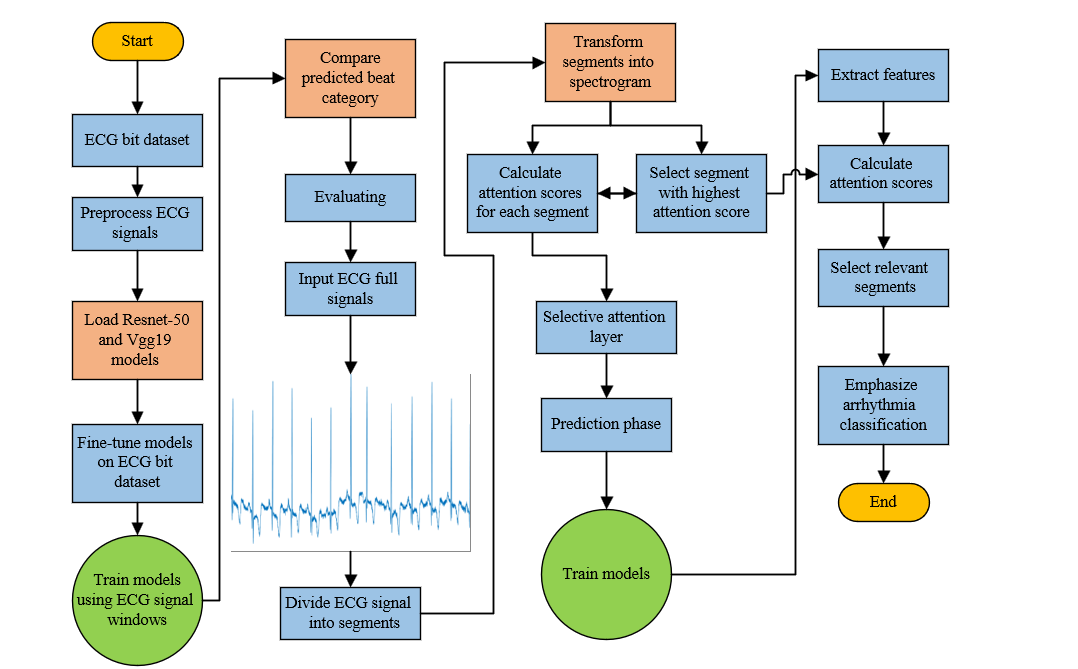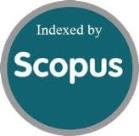Enhanced Electrocardiogram Arrhythmia Diagnosis with Deep Learning and Selective Attention Mechanism
DOI:
https://doi.org/10.46604/aiti.2024.14034Keywords:
arrhythmia diagnosis, electrocardiogram (ECG), deep convolutional network (DCNN), selective attention mechanism (SAM)Abstract
The study aims to improve the diagnosis of arrhythmia in cardiovascular disease management. A novel approach using a deep convolutional network combined with a selective attention mechanism is proposed for electrocardiogram signal classification. The deep convolutional network extracts relevant features directly from raw electrocardiogram signals, while the selective attention mechanism focuses on the most critical regions of the signals and suppresses irrelevant or noisy components. This method achieves an accuracy of 99.70% in multi-class arrhythmia classification and 99.85% in binary classification, significantly outperforming traditional classification algorithms. Furthermore, the selective attention mechanism improves the localization of critical electrocardiogram segments, offering valuable insights for clinicians and aiding in the diagnosis process. This enhanced approach increases diagnostic accuracy and provides a clearer understanding of the electrocardiogram signals, which is crucial for effective patient management in cardiovascular diseases.
References
O. Gaidai, Y. Cao, and S. Loginov, “Global Cardiovascular Diseases Death Rate Prediction,” Current Problems in Cardiology, vol. 48, no. 5, article no. 101622, 2023.
B. R. Smith and E. R. Edelman, “Nanomedicines for Cardiovascular Disease,” Nature Cardiovascular Research, vol. 2, pp. 351-367, 2023.
V. A. Ardeti, V. R. Kolluru, G. T. Varghese, and R. K. Patjoshi, “An Overview on State-of-the-Art Electrocardiogram Signal Processing Methods: Traditional to AI-Based Approaches,” Expert Systems with Applications, vol. 217, article no. 119561, 2023.
T. Anbalagan, M. K. Nath, D. Vijayalakshmi, and A. Anbalagan, “Analysis of Various Techniques for ECG Signal in Healthcare, Past, Present, and Future,” Biomedical Engineering Advances, vol. 6, article no. 100089, 2023.
W. Ullah, I. Siddique, R. M. Zulqarnain, M. M. Alam, I. Ahmad, and U. A. Raza, “Classification of Arrhythmia in Heartbeat Detection Using Deep Learning,” Computational Intelligence and Neuroscience, vol. 2021, no. 1, article no. 2195922, 2021.
O. Taylan, A. S. Alkabaa, H. S. Alqabbaa, E. Pamukçu, and V. Leiva, “Early Prediction in Classification of Cardiovascular Diseases with Machine Learning, Neuro-Fuzzy and Statistical Methods,” Biology, vol. 12, no. 1, article no. 117, 2023.
A. A. Ahmed, W. Ali, T. A. A. Abdullah, and S. J. Malebary, “Classifying Cardiac Arrhythmia from ECG Signal Using 1D CNN Deep Learning Model,” Mathematics, vol. 11, no. 3, article no. 562, 2023.
J. Cui, L. Wang, X. He, V. H. C. de Albuquerque, S. A. AlQahtani, and M. M. Hassan, “Deep Learning-Based Multidimensional Feature Fusion for Classification of ECG Arrhythmia,” Neural Computing and Applications, vol. 35, no. 18, pp. 16073-16087, 2023.
G. B. Moody and R. G. Mark, “The Impact of the MIT-BIH Arrhythmia Database,” IEEE Engineering in Medicine and Biology Magazine, vol. 20, no. 3, pp. 45-50, 2001.
R. Bousseljot, D. Kreiseler, and A. Schnabel, “Nutzung Der EKG-Signaldatenbank CARDIODAT Der PTB Über Das Internet,” Biomedizinische Technik/Biomedical Engineering, vol. 40, no. s1, pp. 317-318, 2009.
Ö. Yıldırım, P. Pławiak, R. S. Tan, and U. R. Acharya, “Arrhythmia Detection Using Deep Convolutional Neural Network with Long Duration ECG Signals,” Computers in Biology and Medicine, vol. 102, pp. 411-420, 2018.
U. R. Acharya, H. Fujita, S. L. Oh, Y. Hagiwara, J. H. Tan, and M. Adam, “Application of Deep Convolutional Neural Network for Automated Detection of Myocardial Infarction Using ECG Signals,” Information Sciences, vol. 415-416, pp. 190-198, 2017.
R. J. Martis, U. R. Acharya, K. M. Mandana, A. K. Ray, and C. Chakraborty, “Cardiac Decision Making Using Higher Order Spectra,” Biomedical Signal Processing and Control, vol. 8, no. 2, pp. 193-203, 2013.
D. Li, J. Zhang, Q. Zhang, and X. Wei, “Classification of ECG Signals Based on 1D Convolution Neural Network,” Proceedings of IEEE 19th International Conference on E-Health Networking, Applications and Services (Healthcom), pp. 1-6, 2017.
J. A. Gutiérrez-Gnecchi, R. Morfin-Magaña, D. Lorias-Espinoza, A. del C. Tellez-Anguiano, E. Reyes-Archundia, A. Méndez-Patiño, et al., “DSP-Based Arrhythmia Classification Using Wavelet Transform and Probabilistic Neural Network,” Biomedical Signal Processing and Control, vol. 32, pp. 44-56, 2017.
N. K. Dewangan and S. P. Shukla, “ECG Arrhythmia Classification Using Discrete Wavelet Transform and Artificial Neural Network,” Proceedings of IEEE International Conference on Recent Trends in Electronics, Information & Communication Technology, pp. 1892-1896, 2016.
C. K. Jha and M. H. Kolekar, “Cardiac Arrhythmia Classification Using Tunable Q-wavelet Transform Based Features and Support Vector Machine Classifier,” Biomedical Signal Processing and Control, vol. 59, article no. 101875, 2020.
M. Wu, Y. Lu, W. Yang, and S. Y. Wong, “A Study on Arrhythmia via ECG Signal Classification Using the Convolutional Neural Network,” Frontiers in Computational Neuroscience, vol. 14, article no. 564015, 2021.
S. M. Qaisar, A. Mihoub, M. Krichen, and H. Nisar, “Multirate Processing with Selective Subbands and Machine Learning for Efficient Arrhythmia Classification,” Sensors, vol. 21, no. 4, article no. 1511, 2021.
F. Murat, O. Yildirim, M. Talo, U. B. Baloglu, Y. Demir, and U. R. Acharya, “Application of Deep Learning Techniques for Heartbeats Detection Using ECG Signals-Analysis and Review,” Computers in Biology and Medicine, vol. 120, article no. 103726, 2020.
U. R. Acharya, S. L. Oh, Y. Hagiwara, J. H. Tan, and H. Adeli, “Deep Convolutional Neural Network for the Automated Detection and Diagnosis of Seizure Using EEG Signals,” Computers in Biology and Medicine, vol. 100, pp. 270-278, 2018.
W. S. Admass and G. A. Bogale, “Retracted: Arrhythmia Classification Using ECG Signal: A Meta-Heuristic Improvement of Optimal Weighted Feature Integration and Attention-Based Hybrid Deep Learning Model,” Biomedical Signal Processing and Control, vol. 87, no. B, article no. 105565, 2024.
M. Kachuee, S. Fazeli, and M. Sarrafzadeh, “ECG Heartbeat Classification: a Deep Transferable Representation,” Proceedings of IEEE International Conference on Healthcare Informatic, pp. 443-444, 2018.
A. H. Abdulaal, M. Valizadeh, M. C. Amirani, and A. F. M. S. Shah, “A Self-Learning Deep Neural Network for Classification of Breast Histopathological Images,” Biomedical Signal Processing and Control, vol. 87, no. B, article no. 105418, 2024.
A. H. Abdulwahhab, A. H. Abdulaal, A. H. T. Al-Ghrair, A. A. Mohammed, and M. Valizadeh, “Detection of Epileptic Seizure Using EEG Signals Analysis Based on Deep Learning Techniques,” Chaos, Solitons & Fractals, vol. 181, article no. 114700, 2024.
A. H. Abdulaal, M. Valizadeh, B. M. Albaker, R. A. Yassin, M. C. Amirani, and A. F. M. S. Shah, “Enhancing Breast Cancer Classification Using a Modified GoogLeNet Architecture with Attention Mechanism,” Al-Iraqia Journal of Scientific Engineering Research, vol. 3, no. 1, pp. 47-63, 2024.
F. A. Elhaj, N. Salim, A. R. Harris, T. T. Swee, and T. Ahmed, “Arrhythmia Recognition and Classification Using Combined Linear and Nonlinear Features of ECG Signals,” Computer Methods and Programs in Biomedicine, vol. 127, pp. 52-63, 2016.
S. Sahoo, B. Kanungo, S. Behera, and S. Sabut, “Multiresolution Wavelet Transform Based Feature Extraction and ECG Classification to Detect Cardiac Abnormalities,” Measurement, vol. 108, pp. 55-66, 2017.
S. K. Pandey and R. R. Janghel, “Automatic Arrhythmia Recognition from Electrocardiogram Signals Using Different Feature Methods with Long Short-Term Memory Network Model,” Signal, Image and Video Processing, vol. 14, pp. 1255-1263, 2020.
Y. D. Daydulo, B. L. Thamineni, and A. A. Dawud, “Cardiac Arrhythmia Detection Using Deep Learning Approach and Time Frequency Representation of ECG Signals,” BMC Medical Informatics and Decision Making, vol. 23, article no. 232, 2023.

Published
How to Cite
Issue
Section
License
Copyright (c) 2025 Hasanain Shakir Mansour, Morteza Valizadeh, Alaa Hussein Abdulaal, Mehdi Chehl Amirani

This work is licensed under a Creative Commons Attribution-NonCommercial 4.0 International License.
Submission of a manuscript implies: that the work described has not been published before that it is not under consideration for publication elsewhere; that if and when the manuscript is accepted for publication. Authors can retain copyright in their articles with no restrictions. is accepted for publication. Authors can retain copyright of their article with no restrictions.
Since Jan. 01, 2019, AITI will publish new articles with Creative Commons Attribution Non-Commercial License, under The Creative Commons Attribution Non-Commercial 4.0 International (CC BY-NC 4.0) License.
The Creative Commons Attribution Non-Commercial (CC-BY-NC) License permits use, distribution and reproduction in any medium, provided the original work is properly cited and is not used for commercial purposes.







